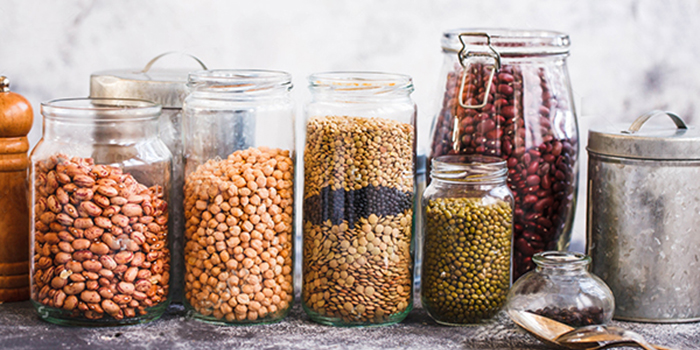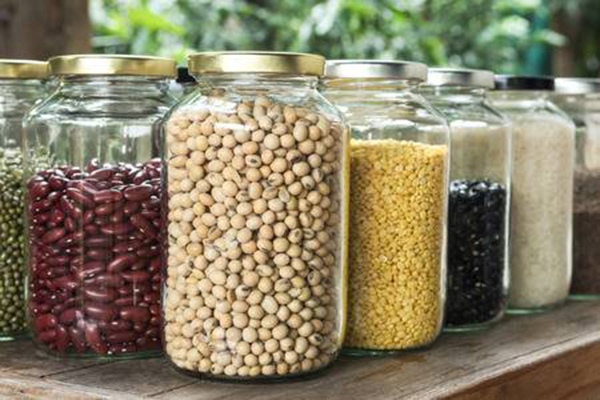Keep these 10 items stocked in your vegan pantry, and mealtime will be a breeze!
I’ve had a lot of people tell me that they’ve switched to a plant-based diet or have decided to go vegan. Since it’s a new way of cooking, starting off can be a little difficult. Even armed with a shelf full of vegan cookbooks, mealtime can be a little tricky, as some of the ingredients can be foreign. Once you get familiar with these items, cooking can be a breeze though.
While I make weekly shopping trips to pick up fresh fruits and vegetables, tofu, tempeh, and seitan, there are certain items I keep stocked in my pantry at all times. I like to keep essentials on hand, as I use them often – sometimes even daily. Having them in the kitchen at the ready makes cooking and meal planning super easy. In addition to spices, herbs, and teas, these are the 10 items in my vegan pantry that I use the most.
My Top 10 Vegan Pantry Essentials
Beans– Beans are extremely nutrient dense, and they’re incredibly versatile, too. They’re great in tacos, pasta dishes, soups, and salads. They can be mashed up and made into burgers or pureed and turned into dips. I like to buy dried beans and cook them myself, either in the slow cooker in the Instant Pot, but I also keep cans of beans on hand for those times when I want something quick. I usually have chickpeas, black beans, cannellinis, and pinto beans in my pantry.
Whole Grains– Like beans, whole grains are also loaded with nutrients. They contain fiber, vitamins, and minerals. They also provide the body with sustained and high-quality energy, and they help regulate blood sugar. I love having quinoa for breakfast and rice with dinner, but I also have less popular grains such amaranth and millet on hand as well.
Nutritional Yeast– Known affectionately as “nooch” in vegan circles, nutritional yeast is deactivated yeast that has a nutty, cheesy taste. It contains protein, vitamins, and minerals, and it’s a good source for vitamin B12. My cats go bonkers for it, as do most of my vegan friends. I use it to make cheese sauce, and I sprinkle it on pasta, popcorn, avocado toast, tofu scramble, and about a million other things.
Chia, Hemp, and Flax Seeds– Most people think of those little terra cotta lambs when they think of chia, but it’s not just for novelty Christmas gifts. While you certainly can sprout them, chia seeds are so packed with nutrients that it’s worthwhile to throw them into smoothies or add them to oatmeal. They’re loaded with fiber, protein, omega-3 fatty acids, and calcium, among other things. They turn gelatinous when wet, so they’re often used as an egg replacer or to make pudding. Flax and hemp seeds are also full of nutrients like fiber, protein, omega-3 fatty acids. It can be a little difficult for our bodies to break down whole flax seeds, so it’s best to grind them before using. Store them in the fridge, as they can go bad pretty quickly. Contrary to what you might hear from late-night comedians, hemp will not get you high. I sprinkle them on my avocado toast, add them to smoothies, and grind them together with nutritional yeast to make dairy-free parmesan.
Raw Cashews – Raw cashews aren’t raw, because the nuts need to be processed with heat in order to remove them from their toxic shells. So what we call raw cashews are actually nuts that haven’t been roasted and salted. Raw cashews are amazing in that they can easily take the place of dairy products by simply blending them with water. If you have a high-powered blender, you don’t need to soak them. If you don’t have a fancy blender, soak them in water for at least two hours before using them in a recipe.
Nut Butters – I always have a few open jars of nut butter in the fridge as well as a few on standby in the pantry. I like to have them on toast for breakfast and with apples as an afternoon snack. And I make my beloved Spicy Peanut Sauce often as part of dinner. In addition to peanut butter, I also love cashew butter and almond butter, and I like to buy mixes, such as Nutzo, too. When buying nut butters, go for the natural kind that’s made with just nuts and mix them yourself when you get home.
Tahini – Tahini is just simply sesame paste. It’s kind of bitter on its own, but once it’s mixed with lemon juice and garlic, something magical happens. I use it often in salad dressings and on sandwiches and I go through jars of it quickly.
Tamari – Tamari is a Japanese variety of soy sauce that’s usually gluten-free. (Always check the labels if you have a food sensitivity!) It typically has a darker color and richer flavor than Chinese varieties of soy sauce, and it’s less salty. I prefer to use it when cooking. I will sometimes use Bragg Liquid Aminos or coconut aminos in place of tamari when cooking.
Non-Dairy Milk – Non-dairy milks can be used in everything from cereals and porridges to sauces and dips. Sometimes I make my own, but often I just buy containers and store them in the pantry. When I first went vegan, soy milk and rice milk were the popular options, but now there are so many more options available, including oat milk, hemp milk, flax milk, and macadamia milk. Almond and coconut milk are my favorites.
Apple Cider Vinegar – I use apple cider vinegar all the time, in salad dressings, stir-fries, and even in drinks. It has many health benefits, and it can help with everything from digestion to cold and flu prevention. When buying apple cider vinegar, I suggest looking for the raw, organic, unfiltered variety. My favorite brand is Bragg.
What are your vegan pantry essentials?
Reprinted with permission from Dianne’s Vegan Kitchen.


Pumpkin and sunflower seeds (I don’t soak before using) as I eat 2 Oz on my salads for a protein. Walnuts (I do soak and then dry in my gas oven) that I have every morning on my hot cereal (steel cut oats, oat groats or hot buckwheat cereal), organic balsamic vinegar for salad dressing as well as rice wine vinegar, Santa Cruz Lemon and Lime Juices,, flaxseed oil for my salad dressing, The Ginger People Minced Ginger (for salad dressings, fruit salads or stir fries), Sir Kensington mustards for salad dressings, a vegan mayo like Follow Your Heart.
Always have garbanzo beans on hand as I make homemade hummus every week, along with legumes like you mentioned, as well as brown and black lentils for making kitchari in the colder months.
About 40 herbs and spices and a good mineral sea salt.